Best Firewood For Wood Ovens 2024
- September 20, 2023
- 2 comment
As 2024 moves forward, the love for cooking in wood-fired ovens keeps growing. These ovens link old traditions to modern cooking, and a lot of their magic comes from the wood you use. The right kind of wood can turn ordinary cooking into something amazing. Let’s find out the best firewood for 2024 that can turn your meals from good to great! Join us as we discover the top choices for firewood that can make your dishes extra special.
Choosing the right firewood is crucial for mastering wood-fired cooking, much like how a chef picks the best ingredients for their dishes. The type of wood you use not only fuels the fire but also enhances the flavors, textures, and the entire cooking experience. Let’s explore the characteristics and benefits of some of the top choices for firewood that can significantly improve your wood-fired oven creations.
Best Firewood for Wood Ovens List:
1. Oak
Oak is often hailed as the “king of hardwoods” for firewood, and for good reason. Its dense grain not only burns slowly but also maintains a steady, intense heat for extended periods. This makes it an excellent choice for cooking methods that require consistent temperatures, such as slow roasting or grilling. The robust flames from oak ensure that heat is distributed evenly, allowing food to cook thoroughly without hot spots.

Additionally, oak imparts a subtle smoky flavor to dishes, enhancing their taste without overpowering the natural flavors. This smoky quality adds a depth of flavor that can elevate simple recipes to gourmet levels. Whether you’re baking bread, roasting meats, or grilling vegetables, oak wood can transform your cooking experience, making it richer and more flavorful. Its versatility and effective heat output make it a top choice for anyone using a wood-fired oven.
2. Ash
Ash wood stands out as a highly practical choice for wood-fired ovens due to its unique burning properties. Unlike most other woods, ash can burn efficiently even when it’s freshly cut, which is quite rare. This makes it incredibly convenient for impromptu cooking sessions when you might not have seasoned wood on hand. Additionally, ash is easy to split thanks to its straight grain, which saves a significant amount of time and effort in preparation.

When it comes to cooking, ash burns with a bright flame and produces a generous amount of heat, ensuring that food is cooked thoroughly and evenly. This makes it particularly suitable for general cooking needs, where maintaining a consistently high temperature is crucial. Whether you’re baking, roasting, or simply heating up your outdoor oven, ash wood provides reliable and effective performance, making it a great go-to option, especially in a pinch.
3. Hickory
Hickory wood is highly regarded, particularly in the American South, for its use in barbecues and smoking due to its strong heat and distinctive smoky aroma. Globally, it has also become a popular choice for wood-fired ovens. Hickory’s robust heat output is ideal for cooking meats, as it provides a high enough temperature to create a delicious char on the outside while keeping the inside moist and juicy. The deep, rich smoky flavor it imparts makes it perfect for dishes where such a taste is desired, enhancing the overall culinary experience.
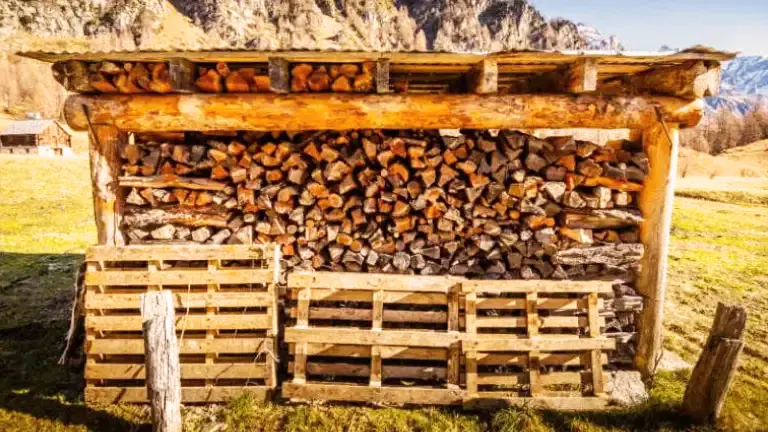
Ideal for smoking and barbecuing, hickory is particularly effective for recipes that benefit from a strong, smoky flavor. It’s excellent for adding a gourmet touch to various meats, turning ordinary dishes into standout meals with its pronounced flavors. Hickory not only cooks the food but also infuses it with a mouthwatering aroma and taste, making it a favorite among culinary enthusiasts who aim to elevate their cooking with a distinct wood-fired essence.
4. Birch
Birch wood, known for its distinctive white bark, offers more than visual charm; it also has culinary benefits when used in wood-fired ovens. Burning birch produces a medium heat accompanied by a light, slightly sweet aroma, which is a reflection of its sap. This gentle and subtly sweet smoke flavor is less invasive than some of the more intense smoking woods, making it perfect for dishes where a delicate touch is appreciated.

Birch is particularly suitable for baking pizzas, breads, and even desserts in a wood oven, as it can enhance these foods with a mild sweetness. This can add a unique flavor dimension that complements the natural tastes of these dishes without overpowering them. Birch’s ability to subtly infuse foods with a sweet aromatic undertone makes it an ideal choice for anyone looking to experiment with different flavors in their wood-fired cooking.
5. Maple
Maple wood, renowned not only for its beautiful autumn leaves and the famous syrup derived from its sap, also excels as a choice for firewood in cooking. When burned in a wood oven, maple provides a steady flame and emits a moderate level of heat, making it suitable for a wide range of culinary applications. The wood’s light, sweet aroma is especially beneficial for dishes where a subtle flavor enhancement is desired without overwhelming the original flavors of the food.
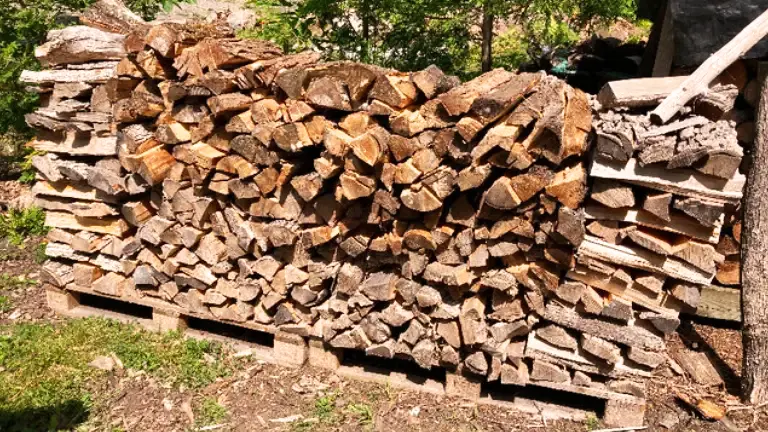
Maple is particularly effective for cooking delicate dishes, seafood, and baked goods. Its mild, aromatic smoke adds a gentle sweetness that can elevate these foods by enhancing their natural tastes without dominating them. This makes maple an excellent choice for those looking to add a nuanced, aromatic touch to their dishes, ensuring that the flavors are enriched rather than masked.
6. Mesquite
Mesquite wood, deeply rooted in the arid landscapes of the Americas, evokes the essence of the Wild West with its robust and earthy flavor. It’s a staple in BBQ pits and smokers, where its intense and slightly tangy smokiness makes a significant impact. When used in wood ovens, mesquite’s characteristics bring a dramatic flair to cooking, burning hot and fast which is ideal for searing meats to perfection. However, the strong flavor profile of mesquite can be polarizing; it is cherished by some for its bold smokiness, while others may find it too overpowering.
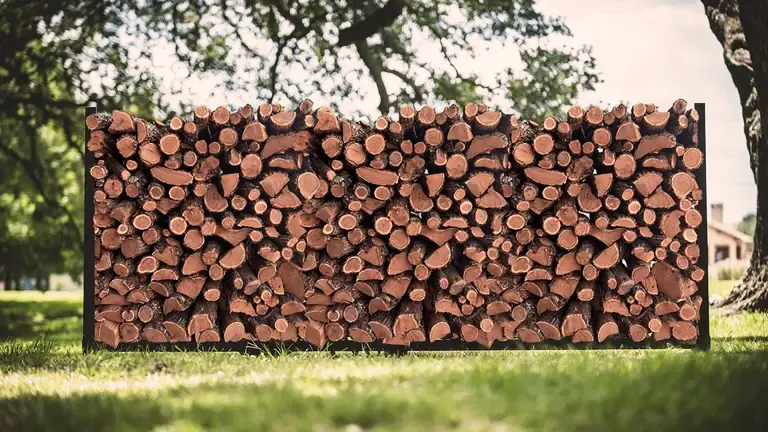
Mesquite is best suited for those with adventurous palates who appreciate a bold flavor experience. Its unique taste profile makes it perfect for dishes that can stand up to its intensity, transforming simple recipes into bold culinary statements.
Special Mentions: Apple and Cherry
While the popular choices like oak and hickory often get the spotlight in the realm of wood-fired cooking, fruit-bearing trees like apple and cherry also hold a special place. These fruitwoods are celebrated not just for their produce but also for their ability to enhance culinary creations with their unique aromatic properties. Known for their subtle, sweet, and slightly fruity smoke, apple and cherry woods bring a gentle yet distinct flavor to dishes that don’t overshadow the ingredients’ inherent tastes.
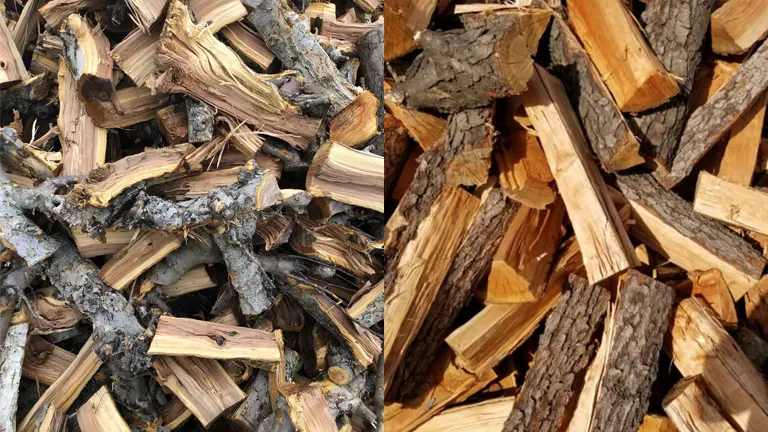
- Apple Wood: Apple wood is particularly valued for its delicate sweetness, which imparts a nuanced aroma to the food. It’s particularly well-suited for white meats, where the gentle smoke can accentuate the natural flavors without overwhelming them. Dishes like chicken or turkey can develop a beautifully golden, crispy skin with a hint of apple, enhancing both their aroma and taste.
- Cherry Wood: Cherry wood, while slightly stronger than apple, offers a similarly aromatic smoke with a tangy fruitiness that’s ideal for fish, particularly salmon. The wood not only flavors the fish but also imparts a beautiful reddish hue, making the dish as visually appealing as it is tasty.
Both types of wood are ideal for dishes that benefit from a soft, flavorful smoke, including poultry, fish, and even certain vegetables and cheeses. Their ability to subtly infuse foods with flavors makes them excellent choices for those looking to add a special touch to their wood-fired cooking without dominating the dish’s natural flavors.
Hardwoods vs. Softwoods
The choice between hardwoods and softwoods is akin to choosing the main ingredient in a recipe. It will define the character of your flame and influence the final dish.
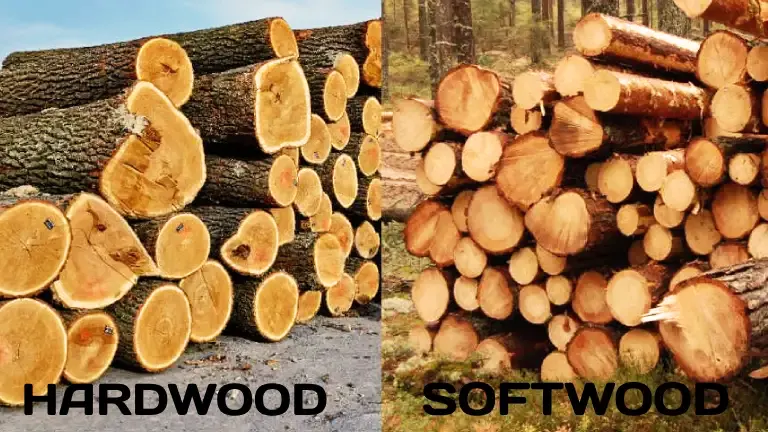
Hardwoods
Derived from deciduous trees that shed their leaves annually, hardwoods such as oak, ash, and hickory have a compact cellular structure. This denseness allows them to burn with a steadier, hotter flame. They produce coals that retain heat for extended periods, ensuring consistent temperatures perfect for cooking dishes that require more time.
Benefits:
- Consistent and prolonged heat.
- Richer, smoky flavor to dishes.
- Less sap, reducing creosote buildup.
Softwoods
Originating from coniferous trees that retain their needles all year round, softwoods like pine, cedar, and spruce have a looser cellular structure. They tend to ignite rapidly due to their resinous nature, making them excellent kindling to start a fire. However, their faster burn rate and lower heat output make them less ideal as the primary wood for cooking.
Benefits:
- Quick ignition.
- Pleasant aroma when burned.
- Ideal for kindling and initial fire starting.
Choosing the right wood type for your oven is pivotal. While softwoods lend themselves to a roaring start, hardwoods are the marathon runners, ensuring your dishes are cooked evenly and imbued with a delicious smoky essence. Before you light your next fire, consider the culinary journey you want to embark on and choose your wood accordingly.
Avoid at All Costs!
In the world of wood-fired cooking, it’s crucial to choose the right type of wood, as the wrong one can significantly diminish the quality of your culinary efforts and potentially harm your oven.
Pine, Spruce, and Cedar are examples of woods that should generally be avoided for cooking. While these softwoods are abundant and ignite quickly, their high sap and resin content poses serious drawbacks. When burned, the sap releases compounds that can impart an undesirable, sometimes acrid flavor to your food, which is far from the smoky subtleties desired in wood-fired cooking.

Additionally, the high resin content in these woods can lead to the production of creosote, a sticky, tar-like substance. Creosote build-up in your oven can decrease its efficiency, require more frequent and difficult cleanings, and even present a significant fire hazard due to its flammable nature. Furthermore, these softwoods burn rapidly, which means they don’t provide the sustained, consistent heat needed for most cooking processes, leading to inefficient fuel use and potentially undercooked meals.
In summary, while the immediate availability and ease of ignition might make pine, spruce, and cedar seem like convenient choices, their negative impacts on both food flavor and oven safety make them unsuitable for wood-fired cooking. Opt instead for hardwoods like oak, maple, or fruitwoods, which burn cleaner and provide a more reliable and flavorful cooking experience.
Seasoned vs. Green Wood
In the realm of wood-fired cooking, it’s not just about the type of wood you choose, but also about its condition. The age-old debate between seasoned and green wood brings to light the nuances of wood preparation, and how it impacts the very essence of your cooking experience. Here’s what you need to know:
Green Wood
Freshly cut from the tree, green wood is aptly named for its high moisture content. This moisture has several implications:

- Struggle to Ignite: The water content in green wood makes it resistant to catching fire easily. You might find yourself using more kindling and spending more time trying to get a stable flame going.
- Smoke Signals: Once it does light, green wood tends to produce a lot of smoke. While some smoke is desired for flavor, excessive smoke can result in a sooty residue on food and a less pleasant, sometimes even bitter, taste.
- Inconsistent Heat: Green wood doesn’t burn as hotly or as consistently as its seasoned counterpart. This can lead to uneven cooking and difficulty in maintaining the desired temperature.
Seasoned Wood
Seasoned wood has been allowed to dry, usually for at least six months to a year. As it dries, it undergoes changes that make it superior for burning:
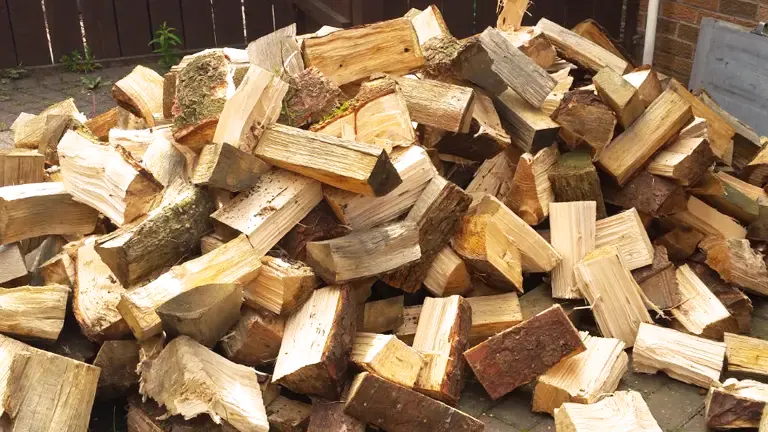
- Easy Ignition: The reduced moisture means seasoned wood catches fire more readily, ensuring you spend less time preparing and more time cooking.
- Clean and Hot Burn: Seasoned wood produces a hotter and cleaner flame, essential for achieving that perfect sear on meats or the crispy base on a pizza.
- Flavorful Without Overpowering: While it still produces smoke, seasoned wood offers a more balanced smoky flavor without the risk of tainting your food with excessive sootiness or bitterness.
Size Matters
For wood ovens, logs shouldn’t be too large. Typically, logs around 3-4 inches in diameter and 16 inches long are ideal. This ensures they catch fire easily and burn efficiently.
Final Thoughts
In the world of wood ovens, the wood you choose truly is the “soul” of your culinary creations. Understanding the nuances of each type can elevate your dishes from ordinary to extraordinary. So, the next time you’re stoking the flames, remember: it’s not just about the fire, but the flavor. Happy cooking!
FAQs
- Why do some chefs swear by specific wood types for certain dishes?
Just like herbs and spices, different woods impart unique flavors to dishes. For instance, hickory might enhance a ribeye steak, while apple wood can elevate a salmon fillet. - I’ve heard of wine pairing, but is there such a thing as wood pairing?
Absolutely! Just as you’d pair a robust red wine with steak or a light white with fish, certain woods complement specific foods. Oak, for instance, works wonders with red meat, while fruitwoods like cherry or apple pair delightfully with poultry and fish. - How can I tell if my wood is seasoned without using it?
Seasoned wood is typically darker, has cracks on the ends, and sounds hollow when knocked. It’s also lighter in weight compared to green wood due to the reduced moisture content. - Is there a “sommelier” equivalent for firewood?
While there isn’t a formal title, many chefs and wood-fired oven enthusiasts develop a deep knowledge and intuition about wood types, flavors, and burns. Engaging with such enthusiasts or communities can provide insights akin to what a wine sommelier offers for vino. - I’ve seen blue or green flames in my wood oven. Is that normal?
Certain minerals in wood can cause flames to turn colors. For instance, the presence of copper can result in green flames. While it’s a fascinating sight, it doesn’t necessarily impact the cooking process or flavor. - Why is pine not recommended when it smells so good?
Pine, along with other softwoods, contains high amounts of sap and resin. While it does have a pleasant aroma, it can lead to creosote buildup in ovens and impart an undesired flavor to food. - Can I mix wood in my oven for a unique flavor profile?
Absolutely! Combining woods, like apple and oak, can produce layered, nuanced flavors. It’s an art, much like blending wines or crafting a unique spice mix. - What’s the best way to store firewood to maintain its quality?
Firewood should be stored off the ground, ideally under a shelter that protects it from rain and snow but allows for airflow. This prevents rot, and mold, and maintains its dryness. - Can I use wood from a tree that’s been treated or painted?
It’s essential to avoid using treated, painted, or stained wood. These can release toxic fumes when burned, which can be harmful to health and taint the flavor of your food. - Do different woods produce different ash profiles?
Yes, different woods produce varying amounts and types of ash. For instance, hardwoods typically produce a fine, powdery ash, while softwoods might produce a more flaky, coarse residue.
We hope you found value in our exploration of the best firewood for wood ovens in 2024. Your experiences and insights matter to us. Feel free to share your thoughts or personal recommendations in the comments. Let’s keep this conversation burning bright!

David Murray
Forestry AuthorI'm David Murry, a forestry equipment specialist with a focus on chainsaw operation. With over 13 years of experience, I've honed my skills in operating and maintaining a wide range of machinery, from chainsaws to log splitters. My passion for the outdoors and commitment to sustainable forestry drive my work, which emphasizes safety, efficiency, and staying updated with industry advancements. Additionally, I'm dedicated to sharing my expertise and promoting environmental awareness within the forestry community.
2 comments
I loved this article. I'm very interested in "wood pairing" and think this is a great way to enhance the joy of outdoor cooking. I enjoy farm to table type cooking on locally cut logs. How fun! I need better chainsaw maintenance skills, but I'll learn. Thank you for the article.










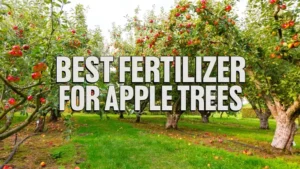


Like working in the outdoors with wood
Allan
September 21, 2023 3:32 am